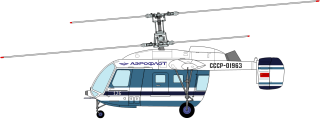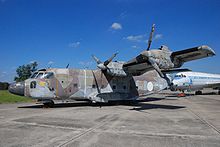The McDonnell Aircraft Corporation was an American aerospace manufacturer based in St. Louis, Missouri. The company was founded on July 6, 1939, by James Smith McDonnell, and was best known for its military fighters, including the F-4 Phantom II, and crewed spacecraft including the Mercury capsule and Gemini capsule. McDonnell Aircraft later merged with the Douglas Aircraft Company to form McDonnell Douglas in 1967.

The Douglas Y1B-7 was a 1930s American bomber aircraft. It was the first US monoplane given the B- 'bomber' designation. The monoplane was more practical and less expensive than the biplane, and the United States Army Air Corps chose to experiment with monoplanes for this reason. At the time the XB-7 was ordered, it was being tested by Douglas Aircraft as an observational plane.

The Douglas YOA-5 was an amphibious aircraft designed for the United States Army Air Corps, based on the Navy's Douglas XP3D. Although a prototype was built, it did not enter production.

The AérospatialeSA 321 Super Frelon is a three-engined heavy transport helicopter produced by aerospace manufacturer Sud Aviation of France. It held the distinction of being the most powerful helicopter to be built in Europe at one point, as well as being the world's fastest helicopter.

The Douglas Dolphin is an American amphibious flying boat. While only 58 were built, they served a wide variety of roles including private air yacht, airliner, military transport, and search and rescue.

The Bréguet Br 960 Vultur was a prototype two-seat carrier-based attack and anti-submarine aircraft (ASW) built for the French Navy during the early 1950s. Meeting contradictory endurance and speed requirements, it was designed as a "mixed-power" aircraft with a turboprop engine in the front and a turbojet in the rear. Only two examples were built, but the second aircraft was rebuilt as the prototype of the Bréguet 1050 Alizé ASW aircraft after the Navy dropped the idea of a turboprop attack aircraft in the mid-1950s.

The Douglas DC-4E was an American experimental airliner that was developed before World War II. The DC-4E never entered production due to being superseded by an entirely new design, the Douglas DC-4/C-54, which proved very successful.

The Douglas C-1 was a cargo/transport aircraft produced by the Douglas Aircraft Corporation for the United States Army Air Service starting in 1925.

The McDonnell 119/220 is a business jet developed and unsuccessfully marketed by McDonnell Aircraft in the late 1950s and early 1960s. Its configuration is unique for this type of aircraft, with four podded engines underneath a low wing. It is the only airplane built by McDonnell Aircraft to be marketed to civil buyers prior to the company's merger with Douglas Aircraft to form McDonnell Douglas. The jet could be outfitted for 10 passengers in a luxury executive configuration and could carry as many as 29.

The Turbomeca Turmo is a family of French turboshaft engines manufactured for helicopter use. Developed from the earlier Turbomeca Artouste, later versions delivered up to 1,300 kW (1,700 shp). A turboprop version was developed for use with the Bréguet 941 transport aircraft.

The Agusta A.101 was a large prototype transport helicopter developed in Italy during the 1960s. Despite prospective orders from the Italian armed forces, no buyers emerged and the project was abandoned in 1971.

The Douglas O-43 was a monoplane observation aircraft used by the United States Army Air Corps.

The Breguet 761/763/765 are a family of 1940s and 1950s French double-deck transport aircraft produced by Breguet Aviation. The aircraft were normally called the Deux-Ponts (Double-Decker) but it was not an official name.

The Douglas Cloudster was a 1920s American biplane aircraft. It was the only product of the Davis-Douglas Company, and was designed to make the first non-stop flight coast-to-coast across the United States.

The Kamov Ka-126 is a Soviet light utility helicopter with co-axial rotors. Evolved from Ka-26 with engine pods removed from stub wings, fitted with one TVO-100 turboshaft engine positioned on top of fuselage, modified rotor blades, new fuel system.
The SNCASE SE.3200 Frelon (Hornet) is a French helicopter built in the late 1950. Intended to serve as a multirole helicopter for the French Army, Air Forces and Navy, two prototypes were built and flown before the project was replaced by the SA 3210 Super Frelon.

The Northrop Delta was an American single-engined passenger transport aircraft of the 1930s. Closely related to Northrop's Gamma mail plane, 13 were produced by the Northrop Corporation, followed by 19 aircraft built under license by Canadian Vickers Limited.
The Douglas DC-8 was an American piston-engined airliner project by Douglas Aircraft. A concept developed more than a decade before the DC-8 jetliner, the piston-engined DC-8 was to have propellers in the tail, an idea first used at Douglas by Edward F. Burton on a fighter project. The airliner project was canceled after development costs made it commercially unviable.
The Douglas XT-30 was a proposed American military advanced trainer. It was never built.
The Bréguet 890 Mercure was a late 1940s French cargo and passenger transport aircraft designed by Bréguet Aviation. Three variants were produced including a military variant called the Mars but none entered production.




















